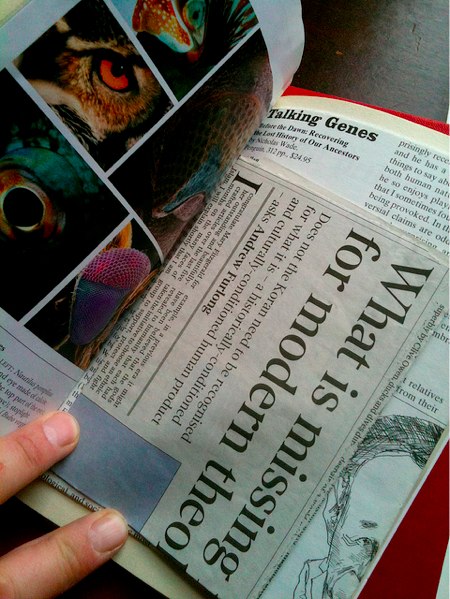
My dad was book mad. He owned a couple of thousand books, mostly non-fiction. He was an old-school, working class, self-taught polymath, a bus conductor-know-all (I’ve written about his dictionaries before). And he had this habit. He would snip cuttings from newspapers and magazines. Almost daily he’d snip a story of some import and file it away inside one of his many books.
And there was method in this compulsive snipping and filing. The cutting always went inside a book of some relevance to the story – cuttings about Kennedy and Nixon inside an American history, cuttings about captured Nazis inside a book about the war. An Alan Coren column in a Thurber collection. Some books were bulging – mum and I used to laugh as we pulled a book down from a shelf and a confetti of cuttings fell out.
But this carefully-assembled distributed scrapbook was pointless – an essentially write-only collection that was destined never to to be seen (the fact that the whole lot was destroyed in a flood at Christmas is just a melancholy full stop to the story). No one was ever going to read or reflect on these cuttings. And there’s an exact parallel with my dad’s manic clipping and saving in the universal curatorial reflex of the social networks. The three-stage process: see something interesting, read it and then – click – it’s shared. It’s a kind of twitch, already so natural that we’ve forgotten how we got started and when.
Sharing is now so part of the process that it influences the kind of content we absorb. I’d love the paywalls to work but I suspect they’ll fail because they short-circuit this curatorial reflex. I cancelled my Times subscription when I realised that being unable to share the marvellous stuff in there – Aaronovitch, Moran, Finkelstein – made it less valuable. I enjoyed it less because I couldn’t share it with my friends. The big publishers can’t ignore the curatorial habit – they’ll have to adjust their offerings to accommodate the twitch.
I clip and save obsessively too (is it a heritable trait?). Since we closed Speechification.com I’ve been posting things at Audiolibre.net and at /Reading. Audiolibre’s a bit like Speechification but I’m sticking to sound recordings that are free to republish. Public domain, creative commons, out-of-copyright stuff that’s explicitly shared by its owners (like the RTE programme that’s at the top now). And there’s plenty of this stuff out there too but it’s a bit of an adventure and I’m looking for new sources (send me your favourites).
And /Reading is a straight copy of James Bridle’s Mattins. He’s been reading bits of books he loves into his phone for a while now (although he’s evidently on a break right now). This is a twist on the trusted guide thing. I trust James to switch me onto writing I wouldn’t have met otherwise and the excerpt he reads makes the whole thing more vivid – and I can listen on the way to work. He’s been reading mainly fiction and poetry but I’m focused (like my old man) on non-fiction – and I’m trying to dig up stuff you won’t find on the non-fiction table at Waterstones. Like this out-of-print anthology of writing about the industrial revolution collected by Mass Observation founder Humphrey Jennings.
/Reading is more of an experiment – should I publish my reading with no commentary or should I add a short review or some context? Will people find my selections useful or are they just bleeding chunks too short to inform a decision? Is this legitimate recommendation or self-indulgence? Will publishers be OK with these short readings? /Reading uses Audioboo because it’s just so accessible (and because it’s easy to lift and embed the audio). For Audiolibre I’ve used an HTML 5 player which means it’ll work on an iPhone or an iPad. Both are available as podcasts and that seems like the right way to package this stuff.
I’ll keep collecting and sharing (because I can’t help it) and I’ll see what happens – tell me what you think and suggest new audio sources and books too.
- /Reading podcast: subscribe directly or via iTunes.
- Audiolibre podcast: subscribe directly or via iTunes.
- Here’s a video of me shouting about curation at an Ignite London event last year.






